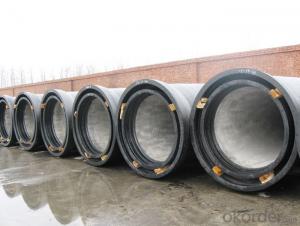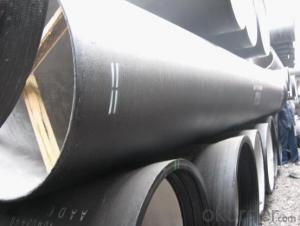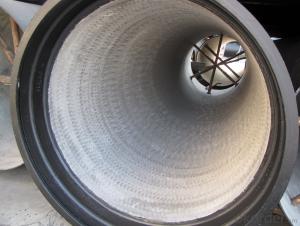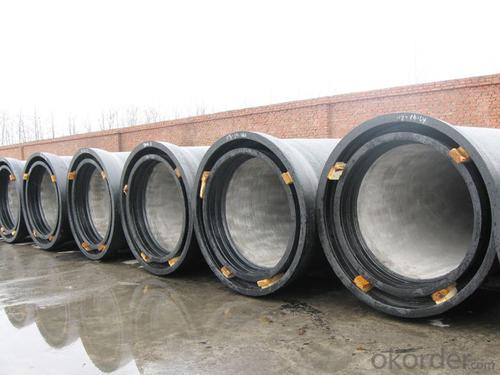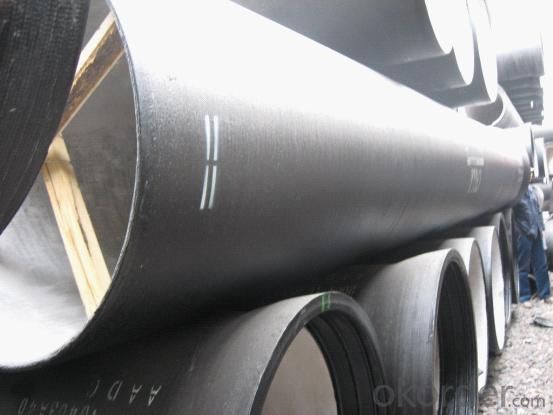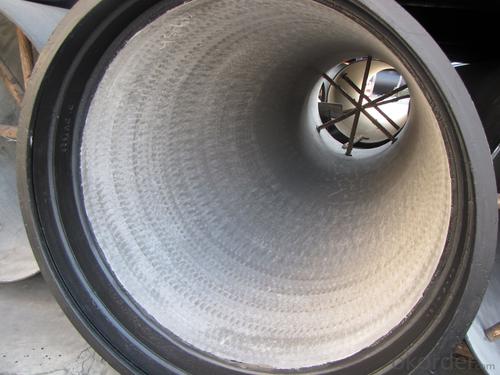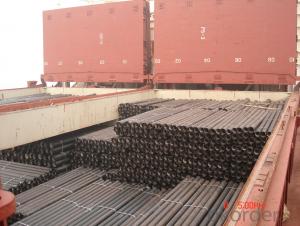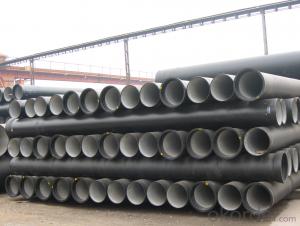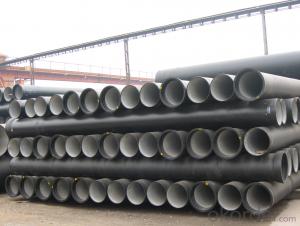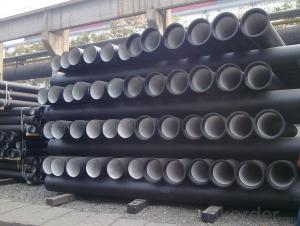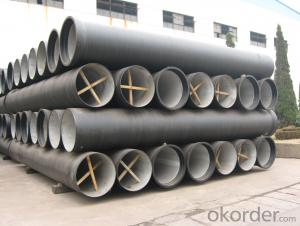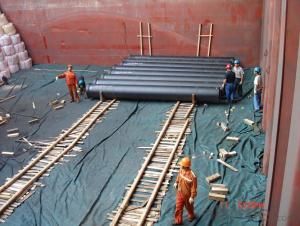Ductile Iron Pipe DN2000 K9/K8
OKorder Service Pledge
Quality Product, Order Online Tracking, Timely Delivery
OKorder Financial Service
Credit Rating, Credit Services, Credit Purchasing
You Might Also Like
Specifications
Quick Details
| Place of Origin: | China (Mainland) | Brand Name: | CMAX | Model Number: | T type / K type / Flange type |
| Length: | 6m / 5.7m / Negotiable | Standard: | ISO2531 / EN545 / EN598 | Application: | Potable / Sewage water |
| Diameter: | DN80~DN2200 | Shape: | Round | Hardness: | 230 |
| Pipe Wall Thickness: | standard | Pull Strength: | 420 | Yield (≥ MPa): | 300 |
| Material: | Ductile Iron | Type: | Centrifugal ductile cast iron pipe | Certification: | ISO2531 / EN545 / EN598 |
| Outer Diameter: | 80-2200 | Thickness: | standard | Specification: | DN80~DN2200 |
| |
The advantages to the customer:
Trustworthy financial strength.
One-stop shopping.
Fast and efficient service.
Coordination of shipments from multiple plants.
Specialists of the overseas shipping process.
A more competitive price.
- Q: Are ductile iron pipes suitable for use in irrigation pivot systems?
- Yes, ductile iron pipes are suitable for use in irrigation pivot systems. They are known for their durability, strength, and resistance to corrosion, making them a reliable choice for transporting water in agricultural applications. Additionally, ductile iron pipes have a high tolerance for pressure and can withstand the stresses caused by irrigation pivot systems.
- Q: How does ductile iron pipe perform in seismic areas?
- Ductile iron pipe performs well in seismic areas due to its inherent strength and flexibility. Its ability to withstand ground movement and vibrations makes it a reliable choice for underground infrastructure in regions prone to earthquakes. Additionally, its robust construction and high resistance to corrosion and damage ensure its durability and safety even in seismically active zones.
- Q: How do ductile iron pipes handle dynamic loads?
- Ductile iron pipes are well-suited to handle dynamic loads due to their high tensile strength and flexibility. The inherent ductility of the material allows the pipes to withstand the stress and strain caused by dynamic loads, such as water hammer or ground movement, without fracturing or breaking. This makes them a reliable choice for applications where frequent load variations or transient events are expected.
- Q: Are ductile iron pipes suitable for use in industrial applications?
- Ductile iron pipes possess the necessary qualities to be used in industrial settings. They are renowned for their robustness and durability, which renders them perfect for handling the rigorous demands of industrial environments. Moreover, these pipes are resistant to corrosion and can endure high pressures and temperatures. Additionally, they exhibit exceptional resistance to impact, thus making them appropriate for areas with heavy traffic or potential mechanical damage. Furthermore, their flexibility allows them to absorb vibrations and shocks, thereby further enhancing their suitability for industrial usage. Consequently, ductile iron pipes are a dependable and cost-efficient option for various industrial sectors, including water and wastewater treatment, mining, power generation, and chemical plants.
- Q: Can ductile iron pipes be used in areas with high soil liquefaction potential?
- No, ductile iron pipes are not recommended for areas with high soil liquefaction potential.
- Q: Are ductile iron pipes suitable for irrigation canal systems?
- Yes, ductile iron pipes are suitable for irrigation canal systems. Ductile iron pipes have high strength and durability, making them resistant to external loads and pressure variations common in irrigation systems. They also have excellent corrosion resistance, ensuring a long lifespan and minimizing maintenance needs. Additionally, ductile iron pipes have smooth interiors, reducing friction and allowing for efficient water flow, which is crucial for irrigation canal systems.
- Q: How does ductile iron pipe compare to steel pipe in terms of durability?
- Ductile iron pipe and steel pipe possess distinct characteristics, but when it comes to durability, ductile iron pipe holds several advantages over its steel counterpart. To begin with, ductile iron pipe boasts exceptional resistance to corrosion. It incorporates a protective layer of zinc or cement lining that safeguards it against rust and corrosion, enhancing its durability and reducing the likelihood of leaks or failures. Conversely, steel pipe is vulnerable to corrosion, particularly when exposed to moisture or specific chemicals. This susceptibility can lead to structural problems and diminish its overall durability. Furthermore, ductile iron pipe exhibits remarkable impact resistance. It can endure substantial loads and external pressures without cracking or breaking, rendering it suitable for applications in high-traffic areas or situations where the pipe may be subject to accidental impacts. Steel pipe, despite its strength, can be more brittle and prone to fractures under similar circumstances. Moreover, ductile iron pipe boasts a longer service life compared to steel pipe. With proper maintenance, it has been known to endure for over a century, making it a dependable and long-lasting choice for infrastructure projects. Steel pipe, although still durable, may necessitate more frequent inspections and maintenance to ensure its longevity. In conclusion, ductile iron pipe surpasses steel pipe in terms of durability due to its corrosion resistance, impact resistance, and extended service life. Nevertheless, the selection between the two ultimately depends on the specific application, budgetary constraints, and other project requirements.
- Q: Can ductile iron pipes be used in underground installations?
- Indeed, underground installations can utilize ductile iron pipes. These pipes are frequently employed in a multitude of subterranean scenarios, such as water distribution systems, sewer systems, and underground fire mains. Their notable attributes encompass robustness, endurance, and resistance to both external strains and corrosion, rendering them fitting for underground installations. Moreover, ductile iron pipes exhibit remarkable adaptability to ground movements and possess the capacity to endure substantial traffic loads. Consequently, they represent a dependable option for underground installations, particularly when stability and longevity emerge as pivotal considerations.
- Q: How is ductile iron pipe protected against external corrosion?
- Ductile iron pipe is protected against external corrosion through a process called external coating. This involves applying a layer of protective coating, such as asphaltic or epoxy, on the outside surface of the pipe. The coating acts as a barrier, preventing moisture and corrosive substances from coming into contact with the iron, thus reducing the risk of corrosion. Additionally, cathodic protection methods, such as applying sacrificial anodes or using impressed current systems, may be employed to further enhance the corrosion resistance of the ductile iron pipe.
- Q: What material is ductile cast iron 235A?
- Pig iron is an alloy of iron and carbon carbon content more than 2%, pig iron carbon content is generally in 2.5%--4%, including C, SI, and Mn, S, P and other elements, is the use of iron ores in blast furnace products. According to the different forms of carbon in pig iron, and can be divided into pig iron, cast iron and steel ball ductile cast iron. Several precipitation of spherical graphite cast iron. The cutting action on the metal substrate than spheroidal graphite flake graphite cast iron, the strength of the matrix organization strength of 70 ~ 90%, the tensile strength is up to 120kgf/mm2, and has good toughness. Ductile iron chemical composition besides iron usually contains: the amount of carbon 3.3.8%, silicon 2.3.0%, manganese, phosphorus, sulfur and no more than 1.5% of the total amount of rare earth, magnesium spheroiditic agent.
Send your message to us
Ductile Iron Pipe DN2000 K9/K8
OKorder Service Pledge
Quality Product, Order Online Tracking, Timely Delivery
OKorder Financial Service
Credit Rating, Credit Services, Credit Purchasing
Similar products
Hot products
Hot Searches
Related keywords
